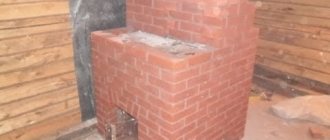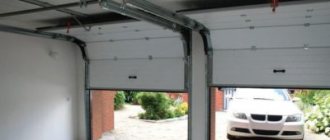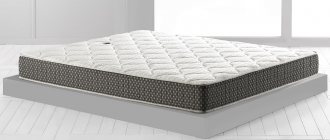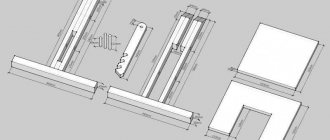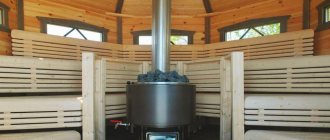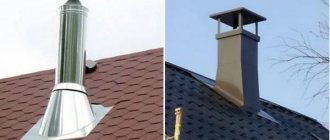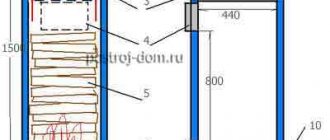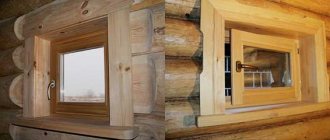Nests for laying hens, built with your own hands from wood. To do this, adhere to the following rules:
- place nests in the shade as far as possible from sunlight;
- choose a dry and warm place;
- To ensure that the flooring is ventilated and the nest remains dry, take care of ventilation or make the bottom of the nest mesh;
- on the ground or at the entrance to the chicken coop it is always colder and more humid - there the bird can easily catch a cold and because of this become less active, so place the nests higher and away from the entrance;
- do not attach the nests directly to the wall: in winter this is uncomfortable for chickens, in addition, this arrangement significantly reduces the service life of the entire structure;
- When making nests for chickens with your own hands, make sure that there are no long nails or chips in the structure, which could cause injury to the bird;
- the number of nests depends on the number of birds: there should be 1 place for every 5 chickens.
When setting up a poultry house, it is important to create optimal living conditions for the birds.
Main types of nests for laying hens
Are you not ready to delve into the intricacies of how to make nests for laying hens? Buy a ready-made version or build a nest from improvised materials. Plastic and wooden boxes, old baskets and cardboard boxes are suitable for this purpose. The main thing is to choose a shaded, secluded place.
If you decide to build a full-fledged nest yourself, first of all decide on the type of structure.
There are two main types of nests for chickens:
- Drawer-shaped design. The design of such a nest is extremely simple and makes it possible to make a whole series of cells for all birds. In addition, it will not be difficult to accustom a chicken to such a nest: to get it used to laying there, it is enough to lock the bird inside for a long time.
- Nest for chickens with an egg collector. This type of nest involves different designs, but the principle is the same for all: the eggs almost immediately fall into a tray specially designed for this purpose and the chicken almost never touches them. This option is especially relevant for large farms, when the number of chickens is high.
An example of homemade nests for chickens with original decor.
Types of nests and their features
There are several types of nests, each of which has its own characteristics, advantages and disadvantages.
| Type of nest | Peculiarities | Advantages |
Nest box | It is a regular box with an opening, inside which hens can lay eggs. | It is very easy to accustom chickens to such a nest - just lock them inside for a few nights |
Nest made from improvised means | Any containers (boxes, buckets, baskets) can be used for the manufacture of structures; the main condition is that they must be clean and intact | The main advantage of nests is low cost |
Nest with egg collector | A special design, which involves a special container into which the eggs are rolled - this greatly facilitates their collection | Making such a structure is much more difficult than others; if serious mistakes are made during nest building, the eggs will break |
When building nests, it is important to take into account the breed of birds: for ordinary laying hens small nests (25x35x35 cm) are suitable, and for meat-egg crosses, structures of at least 30x40x45 are required.
Prices for a nest for laying hens
Nest for laying hens
Video - Trap nest for laying hens
Do-it-yourself nests for laying hens: photos, dimensions, calculation of parameters
One of the most important factors affecting bird comfort is the size of the laying hen nest. It is important to understand that you cannot train a hen to lay eggs in a nest if she is uncomfortable sitting in it.
First of all, the size of the nest for chickens depends on the breed of bird.
Table of correspondence between bird breed and nest size for chickens:
| Bird breed | Socket width, cm | Nest depth, cm | Nest height, cm |
| Laying hen | 25 | 35 | 35 |
| Meat-egg chicken | 30 | 40 | 45 |
Regardless of the breed of bird, the height of the threshold must be at least 5 cm. Also, make sure that there is a special take-off shelf in front of the entrance. Place it at a distance of at least 10 cm from the entrance. The section of the shelf should be 5x2 cm.
If possible, the slope of the roof should be 45° - this will eliminate the desire of birds to sit on top.
Place nests before introducing chickens into the house: this will give them the opportunity to get used to new shelters and get comfortable. Therefore, include drinking bowls in your nest plan in advance, as well as hand-built perches for laying hens: the drawings will help you not to forget anything important and place all objects in the optimal way.
Nests for laying hens made of wood and plastic containers.
Note! The simplest version of a nest for chickens is a “booth” made from a plastic box for vegetables and plywood sheets.
However, it is better to equip more complex nests, since this design turns out to be unnecessarily bulky, and most importantly - not very comfortable, and in winter - even dangerous to the health of the birds.
How to make nests for laying hens: box-shaped design
A little effort on your part and the birds will have a real home where they can feel comfortable, which means they will please you with activity and a lot of eggs.
To make a structure in the form of boxes, you will need the following materials and tools:
- boards, plywood;
- sandpaper;
- fasteners;
- beam;
- screwdriver;
- hammer;
- jigsaw
The process of building a poultry house with your own hands, arranging nests and perches.
Types of nests for laying hens
Rules for placing a chicken nest
Nests for a small number of chickens are made from various available materials:
- boxes;
- boxes;
- baskets
The following designs are popular among poultry farmers:
- In the form of a box . This is the simplest and easiest option. If you lock a chicken in a box for three to five days, she will quickly learn to lay eggs in the right place.
- With egg collector . Laying hens have no opportunity to interact with the egg after she has laid it. The nests are built with a funnel-shaped hole in the center and a sloping floor. The owner collects the products not from the nests themselves, but from special pallets. This option is suitable when there is a large number of chickens and the breeder is very busy, when it is not possible to collect eggs several times during the day.
How to make nests for laying hens with your own hands: drawings and procedures
Creating a comfortable nest for laying hens is not difficult. Follow the instructions and everything will work out even without much experience in building such structures:
- If you use boards for construction, sand them thoroughly using sandpaper.
- Next you need to cut out the blanks. It is important to make accurate calculations of the parameters of the parts you need. First of all, count the required number of cells. Then multiply the resulting number by the width of one cell - it should be at least 25 cm. The height of the box is calculated using the same formula. If there are a lot of birds on your farm, make several floors.
- Pin the cut pieces together.
- To give the structure strength, fasten timber on the inside of the resulting box at the corners.
- The entrance can be left open. Or cut round holes corresponding to the number of places for laying hens and line the box.
- Make a threshold. To do this, take a 10 cm wide strip and fasten it from below along the entire length of the structure divided into cells.
- Step back 10 cm from the entrance to the nest and secure the take-off platform.
- If you have a structure with several tiers, make stairs. There should be one staircase for each tier.
Diagram with installation dimensions of nests for poultry (dimensions for chickens are indicated in brackets).
Note! If the structure has a horizontal roof, coat the surface with stizol to prevent damage from bird droppings.
Instructions for making nests
There are various methods for making nests, which depend on their variety. With a little effort, you can use them to assemble a real house in which birds can nest comfortably and lay eggs. We will consider all possible options below.
Box-shaped
This is a rectangular box, the dimensions of which can be changed depending on the area of the chicken coop and the breed of chickens contained. It can be folded not only in a row, but also in several tiers. An approximate drawing of a two-tier structure looks like this:
There are two ways to assemble such a structure.
Option #1
A box is designed with the following parameters:
- width – 0.25 m;
- height – 0.35 m;
- depth – 0.35-0.45 m.
To assemble such a nest, you need to prepare:
- plywood or boards;
- beam;
- fasteners;
- sandpaper;
- screwdriver;
- hammer;
- jigsaw
When assembling a nest in the form of a box, the procedure is as follows:
- Sand the wood material used.
- Cut out the blanks, strictly adhering to the calculations made in advance. Initially, you need to determine the optimal number of cells, and multiply the resulting number by the width of one cell (at least 25 cm). Using a similar formula, determine the height of the box. When keeping a large number of birds, several floors should be made.
- Connect the pieces together using fasteners like nails.
- From the inside of the resulting box, fasten the beam diagonally (at the corners). Thanks to this, the structure will be more durable.
- Leave the entrance open or cut out entrance holes that correspond to the number of places for laying hens. Next, sheathe the box.
- Make a threshold at least 10 cm wide. To do this, you need to take a strip of suitable dimensions and secure it from below along the entire length of the structure divided into cells.
- Secure the take-off platform at a distance of 10 cm from the inlet.
When building a nest in several tiers, it is necessary to make stairs in such a way that there is one ladder for each tier.
Option No. 2
In this version of making a nest, you will need the same tools as in the previous one. As for the set of necessary materials, it looks like this:
- plywood board 5-15 mm thick;
- square burse with a side of 25 mm;
- a metal mesh for the bottom with a diameter of no more than 7 mm, otherwise chicken feet will get stuck in it, and the flooring for the pallet will fall through;
- fasteners (nails, screws or hardware 15-25 mm long and 2-3 mm thick);
- straw or sawdust for flooring.
The wooden materials used must be well dried so that moisture does not accumulate in the chicken box houses.
Having prepared everything you need, you can start making the nest:
- Sand rough-hewn boards or timber. Initially they can be processed with a plane, and then with a grinding machine.
- Using a jigsaw, cut out the bottom and sides of the drawers from a plywood board.
- Divide the beam into 4 vertical supports 0.3 m high, and then connect them along the perimeter with a horizontal beam to get a structure similar to the frame of a bench without a seat.
- Place a pallet on the assembled frame, which should protrude forward by 10 cm.
- Attach 2 beams to the pallet. They need to be placed one above the other to obtain an elevation of 5 cm. The distance between the double bars is 30-40 cm, so that each of them is under the adjacent wall of neighboring nests.
- Install a metal mesh on a raised surface along the entire length of the assembled structure.
- Place the first tier of boxes without bottoms on the grid, and install a threshold 10-12 cm high as the front wall, otherwise the eggs will fall out of the boxes. The connections of the side walls with the lid and the rear wall should be strengthened from the inside using longitudinal bars.
- On the first tier, again install 2 beams along the edges with a mesh, as was in point 5. Next, build all the upper tiers of boxes. In this case, for each of them you need to install a pallet protruding 10 cm, which will also act as a threshold. A round beam needs to be attached to it along the entire length of the tier to obtain a take-off platform.
- Install the cover of the last tier at an angle of 35-45° relative to the horizon. This is necessary to ensure that laying hens do not sit on it to hatch eggs. However, there is no need for tilting if the distance between the ceiling of the chicken coop and the top cover of the structure is small.
- Using a solid plywood sheet 20-30 cm wide, make a ladder for the upper tiers. To do this, it is enough to nail pieces of timber to the sheet every 10-15 cm.
- Sprinkle sawdust or straw onto the metal mesh. Gradually they will get wet and fall onto the pallet, so they will need to be removed, while renewing the mesh coating.
When assembling a multi-tiered structure, you need to take into account that it is better to assemble the boxes in whole tiers, since in this way you can save plywood by installing common adjacent walls.
With egg receptacle and double bottom
This design is also called a “trap nest” and has the following differences:
- provides a slope for the box in which the chicken will lay, due to which the eggs will roll into a special tray, remaining intact due to the lack of contact with the birds;
- It is equipped with a double bottom, and it is the upper floor that has a slope and a hole through which the eggs will roll into a special collection tray.
Such a nest must have a height of at least 40-45 cm to ensure the necessary bottom slope. Its diagram looks like this:
Such nests can also be arranged in the form of tiers, but in this case you need to take into account that the egg collector is located behind the nest, so you will need to additionally think about collecting eggs from the middle boxes. It can be organized in two ways:
- organize a place for passage between the tiers of the structure and the wall of the chicken coop;
- shorten the length of the tiers to ensure that all eggs can be collected from the sides of the nests.
Regardless of the method chosen, you can use two instructions to make a nest with an egg collector.
Option #1
Along with the basic materials and tools listed above, you also need to prepare:
- plywood slats 2 cm wide for the sides of the pallet;
- glazing beads with a cross section of 10 mm;
- upholstery material for the tray (rubber, non-slip felt, linoleum turned inside out);
- knife and scissors.
Nests with a double bottom are assembled according to the following instructions:
- Calculate the optimal dimensions of the nest, and then increase its height by 5 cm. The optimal dimensions of such a house are 60x35x35 cm.
- After the calculations have been carried out, assemble the supporting structure according to the previously given instructions.
- In front of the assembled frame, identify the locations of the future walls and install short vertical bars 6 cm high if the depth of the pallet is 40 cm. If it is different, it is necessary to calculate the optimal height of the support bars to ensure an angle of inclination of the bottom to the rear wall of the structure of 5°.
- Place the plywood sheet-pallet on the assembled frame so that it protrudes 10 cm forward (for the threshold) and 20 cm behind (for the egg collector).
- Place nests on an inclined tray so that the distance from the back wall to the bottom is 6-8 cm. This creates a passage for the eggs.
- Pin glazing beads around the perimeter of the egg collector to prevent eggs from falling out. In front of them you also need to install vertical slats 2 cm high.
- Cover the bottom of the tray with felt, rubber or other soft material.
- Nail opaque fabric on both sides of the aisle. In addition, it must be elastic so that it bends under the pressure of the eggs. The best option is loose rubberized fabric.
- Set up the take-off platform and sprinkle straw or sawdust on the mesh.
How to construct nests with a trap is described in detail in the video below:
Option No. 2
In this case, after assembling the supporting structure, you must perform the following steps:
- Cut out two halves of the sloping floor measuring 35x15 cm. When they are attached, a gap should form into which eggs can freely pass. Attach one blank to the back wall at a height of 20 cm and at an angle of 15°.
- Attach two partitions in place of the front wall. To the bottom of them, measuring 10x35 cm, first nail the second half of the inclined floor. There should be a gap between it and the bottom for the collection tray.
- Attach a second partition measuring 15x35 cm to the top of the nest to cover the entrance.
- Make a pull-out tray by knocking it down to size or using any suitable pallet. Its depth should be 10 cm greater than the depth of the nest, otherwise it will not be possible to freely collect eggs from the outside. Place the tray at an angle of 5°. Line the bottom with a thick layer of soft material so that the eggs land softly and do not break.
It is recommended to make the floor in the nest mesh to ensure ventilation of the flooring. To do this, you can use wire, which will need to be woven, leaving cells measuring 4x5 cm. Bedding in the form of straw or sawdust should be placed on such a floor.
To combat pecking, you can use homemade roll-out nests. How to make them is described in the following video:
With egg container
In this case, the nest is equipped with a special egg container, which will serve as an egg collector. To make the structure you will need:
- plywood sheet, chipboard;
- egg container;
- soft material;
- nails;
- hacksaw;
- milk
The design is made in the following sequence:
- Assemble the box using the previously described methods, taking into account that the bottom must be secured at an angle of 10°.
- Cut an entry hole and cover the front of the nest.
- On the lower part of the back wall, cut a hole whose diameter is slightly larger than a chicken egg.
- Place a container under the bottom, first covering it with soft material so that the eggs do not break during rolling. However, there should be little upholstery material so that it does not prevent eggs from entering the container.
The bottom of the nest should be covered with a thin layer of flooring, otherwise it may make it difficult for the eggs to roll into the tray.
How to make a nest for chickens with a tray for collecting eggs is clearly shown in the following video:
Hanging nests
Similar designs can be made from various available materials. For example, ready-made lightweight wooden boxes or plastic boxes with a lattice bottom, which are often used for storing fruit, are an excellent option.
The main criterion for such a design is sufficient strength, since hinged sockets lack support, as they are attached only with side fastenings. If there is no confidence that the structure will support a hen with laid eggs, a soft box should be installed with additional fastenings in the form of wire cords that will support its edges to the wall of the chicken coop.
Hanging nests must be insulated using the following materials:
- felt;
- thick woolen fabric;
- polystyrene foam covered with thin plywood;
- compacted straw.
You should not use mineral wool as insulation, as it can easily be damaged by insects.
The wall that is adjacent to the main wall of the chicken coop needs insulation. To lighten the weight of the structure, it is better to use thin plywood up to 0.5 cm thick as the back wall of the nest. The insulating material must be sandwiched between it and the wall of the chicken coop.
Of course, hanging nests can also be assembled from wooden material, following these instructions:
- Prepare a drawing based on the size of the chicken coop.
- Build a frame from timber measuring 5x5 cm and attach plywood to it.
- Build the bottom using timber or metal mesh.
- Attach the sheathing material, and lay insulation on top of it.
- Connect all the parts of the nest together with bolts with the sheathed side facing inward, and then drill holes in the rear bars in order to subsequently attach them to the wall of the chicken coop.
- For free access to the eggs, build a door in the front part of the structure, which is also insulated.
- Attach the roof in the form of a sheet of plywood. Its surface should be covered with foil, and metal tiles should be laid on top of it.
- Build partitions, placing them in the inside of the nest. To do this, cut a sheet of the required size and attach it to the bottom using strips.
Hanging nests are an excellent option for wooden chicken coops because they allow for more efficient use of available space. However, you should remember the need to insulate them.
Nest option for laying hens to prevent eggs from being pecked: double bottom design
If you are busy during the day and cannot constantly monitor the chickens, you can make a more complex version of the nest. There are two types of structures that include an egg collector:
- double bottom design;
- with egg container.
To build a double bottom nest you will need the following materials and tools:
- thin plywood boards;
- fasteners;
- material suitable for pallet upholstery;
- sandpaper;
One of the options for a nest for laying hens with a mesh floor and an egg collector.
- screwdriver;
- hacksaw;
- hammer;
- knife;
- scissors.
Basic rules for building a nest with your own hands:
- do not take long nails: those sticking out from the outside can easily injure birds;
- after constructing the nest, carefully inspect it for nicks, chips, and make sure the strength of the structure in order to protect the birds from injury;
- To ensure the comfort of the birds, lay sawdust, straw or hay on the floor. Regularly change the filling and clean the nest from droppings;
- In order for chickens to feel comfortable, the microclimate is of great importance. Place nests in a dry place, protected from drafts.
The egg receptacle will allow you to keep the eggs intact, which is especially important with a high number of chickens.
Instructions on how to make a nest for laying hens with an egg collector with your own hands (photos, dimensions and drawings are easy to find on the Internet):
- Make a design based on the principle of a doghouse. Pay special attention to the bottom: in this version of the nest it should have a slight (about 5°) slope towards the rear wall of the structure. Leave a gap the size of the egg between the wall and the bottom.
- Make a pallet. For upholstery, choose a soft, non-slip material: fabric, felt, the back of linoleum, rubber. The length of the tray should be 10 cm greater than the depth of the nest - this is necessary to ensure easy access to eggs from the outside.
- Attach a bar to keep the eggs from falling.
- Attach the tray to the main part of the nest, maintaining a slope of 5°. This will cause the egg to roll off and end up in the bottom tray, where it will remain safe until you pick it up.
Note! The floor in such a nest should be made of mesh. This solution helps to ventilate the flooring. A good material for making a floor is wire: weave it, leaving gaps of 4x5 mm, and place the bedding material on top.
The design of chicken nests with a double bottom is convenient and practical.
What types of nests are there?
Types of nests:
- Nests with egg collectors have several design variations. But this is the most optimal type, of course you will have to tinker with it. It is good because the chicken is in contact with the egg for a minimum amount of time and the egg will not fall under the chicken’s feet, but into a separate container. Therefore, it will not be trampled or pecked, this is especially convenient with a large number of laying hens.
- Nests made from scrap materials, i.e. any clean, capacious container: an empty box, box, wicker basket, etc. This option can be used with a small population, or just for beginning poultry farmers, temporarily or even permanently.
- Nests in the form of boxes are chicken houses-boxes with an opening; they have several cells, inside, a cozy space where, perhaps, 3-4 laying hens or more can comfortably lay at the same time.
Nest boxes
- Take wooden material and cut out the workpiece to the required size.
- Having previously calculated the number of cells you need.
- This is done by dividing the length of the entire structure by the desired width of 1 cell.
- Height is determined in a similar way.
- Next, using large nails or screws, we connect the workpiece together, starting from the bottom, and strengthen it on the sides with timber.
- We carefully cut out the entrance hole for the hens, make a threshold (at least 10 cm wide) and a platform for the hen to take off, with a distance of 10–14 cm from the entrance hole. If the nest boxes are multi-tiered, add stairs to them.
From scrap materials
- Various available materials are also good: cut old car tires, unnecessary boxes, bookshelves and other shelves, any unnecessary containers, buckets, etc.
- The main thing is that the nest is the right size, spacious, comfortable, clean, and does not have gross defects in the form of chips, burrs, etc.
- These containers, of course, are not durable, but they will perform their functions perfectly.
- They are filled with sawdust or hay, preferably fresh.
- And once installed, they cover it with curtains for the hens’ peace of mind.
Nests-egg collectors
A little difficult to perform, but the result itself will definitely please you. Especially if it is not possible to often look into the chicken coop.
This can be done in 2 ways:
- nest with 2 bottoms;
- special container.
For a nest with 2 bottoms you will need:
- lumber;
- fasteners;
- tools: hacksaw, knife, hammer, etc.;
- for bottom upholstery: non-slip material: linoleum, thick fabric, rubber, plywood, felt, etc.
Algorithm of actions:
- Build a nest according to the well-known doghouse principle. Immediately make a drawing, mark and cut out the parts, and clean up.
- The bottom here is special; it must be attached at a slope (5–13°) to the back wall. Make sure that there is a good gap between the bottom and the wall; the egg should roll freely into it.
- Now let’s take the tray; it should be slightly longer than the nest, about 10–14 cm. This is done in order to collect eggs without any problems. We upholster it with unnecessary but soft material and stuff a bar in front to prevent the eggs from rolling off.
- Fix the pallet tightly to its main structure at a slope of 5–7° so that the dietary product can roll off without being damaged.
Nest with regular container, materials you need:
- chipboard;
- select or make an egg collector;
- upholstery;
- tools, large nails;
- gloves.
Job:
- We first make it according to the general principle, or the one indicated above: we build a strong box, connect the walls, make sure that the bottom has a slope of 8–10°, make a waterproof roof, close the front, not forgetting to cut a good inlet hole.
- We cut a hole in the back and bottom, slightly larger than the diameter of the egg. And we place the container down, do not forget to cover it with fabric first.
How to make a nest with an egg container
To make a wooden nest with an egg collector, you will need the following materials and tools:
- hacksaw;
- nails;
- hammer;
- soft material;
- Chipboard and plywood;
- egg container.
The work order is as follows:
- Build a box, fasten the side walls, secure the bottom at an angle of 10°, make a roof.
- Cut an entry hole and cover the front of the nest.
- On the bottom back wall, cut a hole slightly larger than a chicken egg.
- Place a container with soft material under the bottom. Now, when the eggs roll off and fall into the pan, they will be reliably protected from damage.
Provide that, given the sloping bottom, there is always a minimum amount of flooring in the nest, otherwise it may become an obstacle and make it difficult for the eggs to roll into the tray.
After you have built nests and perches for chickens with your own hands, you can move on to an equally important aspect of arranging a chicken coop - perches for birds.
Do-it-yourself perches for laying hens: photos, sizes, construction tips
Any owner knows that all chickens prefer to rest and sleep on the roost. This crossbar can be round or square in cross-section and belong to one of many types. The appropriate type should be selected based on the available space and the number of birds on the farm.
Arranging a perch is one of the most important stages in building a poultry house.
Types of chicken roosts
Perches designed for chickens come in different designs:
- perches located at different levels. This option is relevant when there are a lot of chickens on the farm, and the area of the chicken coop is small. The main disadvantage of this design is that in such a chicken coop the birds will constantly quarrel over a higher place, and the chickens sitting on top will stain those located below them with droppings;
- several crossbars fixed at the same level on the wall or along the perimeter of the poultry house. An ideal option for laying hens, allowing them to choose the most comfortable position without disturbing other birds;
- perches that are fixed to vertical posts. Bird-friendly design that is easy to construct. The best option for those who want to construct a roost for chickens with their own hands;
- table equipped with crossbars. This design is convenient for its mobility. The table is easy to carry, convenient to disinfect and clean;
- box with perches. It is also distinguished by its mobility - if necessary, it can be easily moved from place to place. The main disadvantage of this solution is the small number of places to place birds. Thus, this option is relevant only for a small farm.
Note! Understanding how to make perches for chickens is not at all difficult, as is making this element of the chicken coop yourself. In this case, you can be sure that the perch meets all your needs and the characteristics of your farm.
Scheme of arranging a chicken coop with optimal dimensions for the location of perches and nests.
How to make a roost for chickens yourself: a detailed algorithm of actions
Step-by-step instructions for creating a perch for laying hens:
- Prepare a plane, nails, hammer, sandpaper and wooden blocks. The cross-section of the beams should be 40x60 cm.
- Calculate the size of the perch based on the number of chickens in your household and considerations for their comfortable placement. For example, 10 egg-laying hens require 2.4 m of crossbar. The optimal solution would be to divide the perch into 2 parts - 2 crossbars (each length is 1.2 m).
- Take 2 planks for support. Their length should be 0.6 m. Install them on opposite walls at a height of 0.9 m from the floor and a distance of 0.3 cm from the wall on which you plan to place the perch.
- Take the timber from which you will make the crossbar. Treat it so that there are no burrs or chips left on the surface. Cut off sharp edges with a plane, and use sandpaper for sanding.
- Nail the ends of the crossbar to the support strips at a distance of 30 cm from the wall.
- Retreat the same amount. Drive in the second crossbar.
- Step back 0.4 m from the floor. Nail the bars to the side walls.
- Attach several boards to the blocks - they will serve as the basis for the pallet.
- Install a tray to catch the droppings. For its manufacture, you can use sheet metal. A regular wooden shield is also suitable for these purposes.
- Make a staircase from the remaining blocks.
By building a chicken coop with your own hands, you get a structure that is ideally suited to the conditions of your farm.
Typical drawings of nests for laying hens with dimensions
Socket drawing Option 1
Socket drawing Option 2
Drawing of a nest with street access
All dimensions are shown in Figures 2-6
1
2
3
4
5
6
7
8
9
10
11
12
Where is the best place to place a roost for chickens?
The perch should be located away from the door - this way you will protect the birds from drafts and, as a result, possible health problems. Choose the warmest place in the room. You also need to have plenty of light, so placing the perch near a window is a good idea. It is convenient when there is a shield under the perch into which droppings fall. This makes cleaning the chicken coop more comfortable. To make droppings less sticky to the boards, sprinkle the tray with sawdust or sand. When making a pallet, ensure that it can be easily disassembled - this will make caring for the poultry house as simple as possible.
How to build a winter chicken coop: (read more)
Place the perch at a height of at least 0.6 m and no more than 1 m from the floor. The cross-section of the crossbar used for perching should be 5-7 cm. The calculation is based on half the length of the open chicken foot, measured from the beginning of the middle finger to the end of the thumb. In order not to lose balance, the chicken needs to tightly clasp the crossbar with its paws. Make sure that each bird has at least 18 cm on the perch if the chicken is an egg breed, and at least 25 cm for birds of the meat and egg breed. Building a nest and perch for chickens with your own hands is not that difficult. Independent choice of device, materials, sizes and other parameters will allow you to get a design that is ideally suited to the conditions of your farm.
